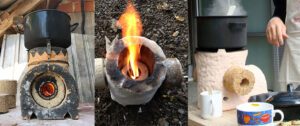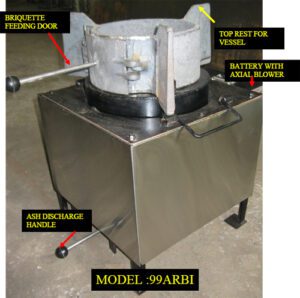How Biomass Briquettes for Domestic Cooking
- Using biomass briquettes for power cooking is an environmentally friendly and sustainable alternative to traditional fossil fuels like coal or charcoal.
- Biomass briquettes are made from renewable biomass materials such as agricultural waste, wood residues, sawdust, or other organic materials.
- Here’s how biomass briquettes can be used for power cooking:
Biomass Briquette Stove:
- To utilize biomass briquettes for power cooking, you’ll need a specialized stove or cooker designed to burn briquettes efficiently.
- Biomass briquette stoves are designed to provide a controlled and clean combustion process, ensuring high thermal efficiency and minimal smoke emission.

Types of biomass briquette
- These are just a few examples of biomass briquettes, but there are other types and variations available depending on the specific biomass feedstock and production processes used.
- The choice of briquette type depends on factors such as availability of biomass resources, intended use, desired energy output, and local market preferences.
- It’s important to ensure that the biomass feedstock used for briquette production is sustainable, responsibly sourced, and does not contribute to deforestation or environmental degradation.

There are various types of biomass briquettes available, and the choice of briquette type depends on the specific biomass feedstock and its intended use. Here are some commonly used types of biomass briquettes:
Wood Briquettes:
- Wood briquettes are made from wood residues, such as sawdust, wood chips, or shavings.
- They are widely used for heating and cooking purposes due to their high calorific value and consistent burning properties. Wood briquettes are commonly used in residential heating, industrial boilers, and biomass power plants.
Agricultural Briquettes:
- Agricultural briquettes are produced from agricultural residues, including rice husks, straw, corn stalks, bagasse (sugarcane waste), and others.
- These briquettes are primarily used as a fuel source in rural areas for cooking and heating. Agricultural briquettes can be an effective way to utilize agricultural waste and promote sustainable farming practices.
Biomass Pellets:
- While not technically briquettes, biomass pellets are another form of compressed biomass fuel.
- Pellets are typically cylindrical in shape and are made by compressing biomass materials, such as wood chips or agricultural residues, under high pressure without the use of binders.
- Biomass pellets have a standardized size and shape and are commonly used in pellet stoves, biomass boilers, and industrial applications.
Charcoal Briquettes:
- Charcoal briquettes are produced from carbonized biomass, such as charcoal dust, carbonized rice husks, or coconut shell charcoal.
- These briquettes are widely used for cooking and grilling due to their high heat output, long burning time, and low smoke emission.
- Charcoal briquettes are often used as a sustainable alternative to traditional charcoal made from wood.
Paper Briquettes:
- Paper briquettes are made from shredded paper or cardboard mixed with biomass materials. They are commonly used in small-scale applications or for emergency fuel needs. Paper briquettes are easy to produce and provide a way to recycle paper waste while utilizing biomass materials for fuel.
Briquette Placement
- Place the biomass briquettes inside the stove’s combustion chamber or designated fuel holder.
- The design of the stove should allow proper airflow to support the combustion process and provide sufficient heat for cooking.
Ignition:
- Ignite the biomass briquettes using a small amount of kindling or other easily flammable materials.
- Once the briquettes catch fire and start burning, they should produce a consistent and steady flame.
Cooking:
- With the briquettes burning steadily, you can now place your cooking utensils on the stove and start cooking your food.
- Biomass briquettes provide a reliable and consistent source of heat for cooking various types of food.
Steps in Biomass Briquette Process
The biomass briquette manufacturing process involves several steps to convert biomass materials into compact and energy-dense briquettes. Here’s a general overview of the biomass briquette production process:
Raw Material Preparation
-
- The first step is to collect and prepare the biomass materials. Common biomass feedstocks include agricultural residues (such as rice husks, straws, or corn stalks), forestry residues (like wood chips, sawdust, or bark), or other organic waste materials.
- The raw materials need to be dried to reduce their moisture content, as excess moisture can hinder the briquette formation process.
Size Reduction:
-
- Depending on the size and form of the raw materials, they may need to be further processed to achieve the desired particle size for briquetting.
- Size reduction methods can include chopping, shredding, grinding, or milling biomass materials.
Mixing (Optional)
-
- In some cases, it may be necessary to mix different types of biomass materials or add binders to improve the briquette’s binding properties. Binders, such as starch, clay, or molasses, can enhance the cohesion and strength of the briquettes.
- The mixing step ensures uniform distribution of the binder within the biomass feedstock.
Briquette Formation:
-
- The prepared biomass material is fed into a briquette machine or briquette press.
- The machine applies mechanical pressure to compact the biomass and bind it together into briquettes.
- There are different types of briquette machines, such as screw extruders, piston presses, or hydraulic presses, each with its own operating principle.
Drying
-
- After the briquettes are formed, they typically have a high moisture content.
- Drying is necessary to reduce the moisture level and increase the briquettes’ strength and stability. The drying process can be accomplished naturally by air drying, or through mechanical drying techniques such as using hot air or kilns.
Cooling and Packaging:
-
- Once the briquettes are adequately dried, they need to be cooled down to room temperature. After cooling, the briquettes can be packaged and stored for distribution or immediate use.
- It’s important to note that the specific process may vary depending on the type of briquette machine, binder usage, and desired briquette characteristics.
- Additionally, advanced briquette production systems may include additional steps like sieving, sieving, or carbonization to produce charcoal briquettes.
- The quality of biomass briquettes depends on factors such as raw material quality, particle size, moisture content, binder selection, and the operating parameters of the briquette machine. Optimizing these factors can result in high-quality briquettes with consistent combustion properties.
- It’s always recommended to follow proper guidelines and consult experts or manufacturers of briquette machines for detailed instructions and best practices regarding the biomass briquette production process.

Advantages of using biomass briquettes for Power cooking
Advantages of using biomass briquettes for power cooking:
Renewable and Sustainable:
- Biomass briquettes are made from waste materials, which helps reduce the burden on natural resources and promotes sustainable waste management practices.
Reduced Smoke Emission
- High-quality briquettes and efficient stoves produce minimal smoke and harmful emissions compared to traditional cooking methods, leading to improved indoor air quality and reduced health risks.
Energy Efficiency:
- Biomass briquettes have a higher energy density than raw biomass materials, making them more efficient for cooking and heating purposes.
Carbon Neutral:
- The carbon released during the combustion of biomass briquettes is approximately equal to the carbon absorbed during the growth of the biomass source, making them carbon-neutral.
Cost-Effective:
-
- In regions where biomass is abundant, using biomass briquettes can be a cost-effective cooking solution compared to other fuels.
- Using biomass briquettes for power cooking can be an excellent way to promote sustainable cooking practices, especially in areas where traditional cooking fuels are scarce, expensive, or environmentally detrimental.
- However, it’s essential to ensure that the biomass used for briquette production is sourced responsibly and doesn’t contribute to deforestation or environmental degradation.
- Additionally, regular maintenance of the briquette stove is crucial to ensure optimal performance and safety during cooking.


